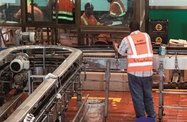New listing requirements for Tanzania’s mining companies are key components of the government’s plans to use the upstream extractive sector to stoke broader economic growth.
First mooted in 2010, the government announced in September new regulations stipulating that companies holding special mining licences – which extend up to 25 years – must list at least 30% of their shares on the Dar Es Salaam Stock Exchange (DSE) within two years or risk having their licence cancelled.
Special licence holders are also required to have a minimum of 30% local ownership of paid-up shares under the new regulations. As of last year, 80 companies had either a mining licence or special mining licence, with 228 companies holding prospecting licences, according to figures from the Ministry of Energy and Minerals (MoEM).
Capital market impact
The move could potentially spark a rise in activity on the local equity market, where trading and listings are relatively modest.
Currently, there are 25 companies listed on the DSE, 18 of which are domestic firms and the remaining seven are cross-listings. Only one company on the DSE – cross-listed Acacia Mining – is involved in the mineral extraction industry.
The government’s plan to require eligible mining firms to list on the exchange could – if investor appetite is whetted – greatly increase the DSE’s market capitalisation, which stood at TZS20.9bn ($9.6m) as of late November.
However, there are some concerns that there may not be enough domestic investors willing to buy into the mining sector, particularly if the market is flooded with shares. One proposal from the industry is that the listing of shares be conducted in stages, taking into account liquidity levels and demand.
Flowing downstream
The government is also looking to boost value addition and employment via the mining industry through the development of a broader downstream component.
To this end, in April President John Magufuli called on mining companies to build more smelters to process extracted metals and minerals.
There has been some encouraging news on this front. At the end of August, Australian-listed graphite company Kibaran Resources announced it had begun a feasibility study on increasing downstream processing capacity at its Epanko Graphite Project (EGP) in the Ulanga district of Morogoro.
The company is looking to expand the mine’s production capacity from 40,000 tonnes per annum (tpa) to 60,000 tpa after sealing a deal with Japanese trading company Sojitz to export a minimum of 14,000 tpa of battery-grade graphite for the next five years, which Sojitz will distribute to the lithium battery industry in Japan, Korea and Taiwan, according to press reports.
This is in addition to agreements already in place to export 30,000 tonnes of graphite from EGP per year, including 20,000 tonnes for use by Germany’s ThyssenKrupp.
Expanded capacity
However, for many of the other metal and mineral categories, increasing downstream capacity will necessitate a significant rise in current upstream production.
While the exported concentrates of copper and silver are currently processed abroad, the separation process is costly and requires advanced technology. According to Ami Mpungwe, chairman of the Tanzania Chamber of Energy and Minerals, the current volume of output at Tanzania’s ore mines does not make the building of such a smelter commercially viable.
With a mixed concentrate output of around 60,000 tpa, building a specialised smelter would not make economic sense, Mpungwe told international press in mid-November, with at least 150,000 tpa needed to justify such a project.
Mining contributions
The efforts to expand the positive externalities of the mining sector are laudable, given Tanzania’s campaign to become a semi-industrialised, middle-income economy by 2025.
The sector already accounts for roughly 4% of GDP, a figure the government is looking to increase, according to Ali Samaje, acting commissioner at the MoEM. Currently, Tanzania is Africa’s fourth-largest gold producer, with the segment generating export earnings of $1.27bn in 2015, a figure set to rise as gold prices rebound from lows seen last year.
Tanzania’s mineral wealth also includes extensive reserves of diamonds, iron ore, nickel, uranium, coal and graphite, with the industry developing as an increasingly important contributor to the national economy.
In mid-October the government also announced it would promote private investment in eight sectors as part of its plan to broaden the base of the economy, including mining, alongside manufacturing, infrastructure development, agriculture, tourism, fishing, power generation and ICT.
Oxford Business Group is now on Instagram. Follow us here for news and stunning imagery from the more than 30 markets we cover.

